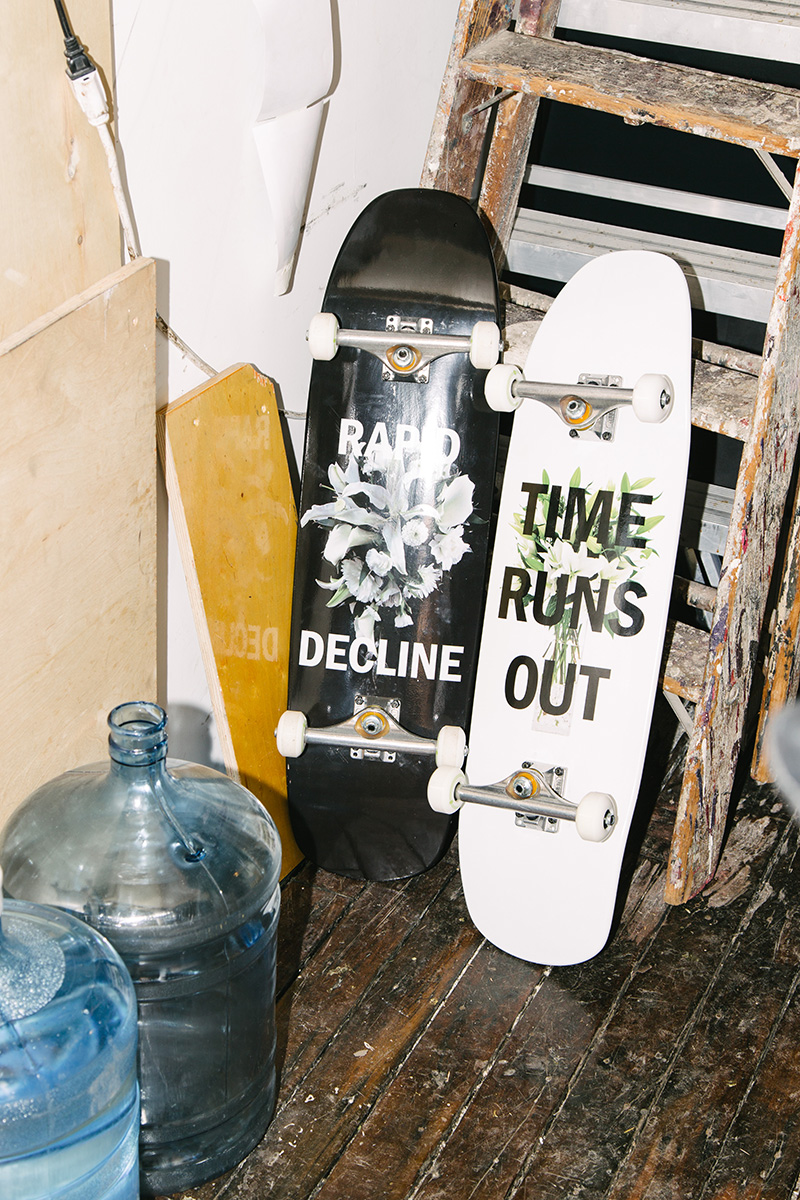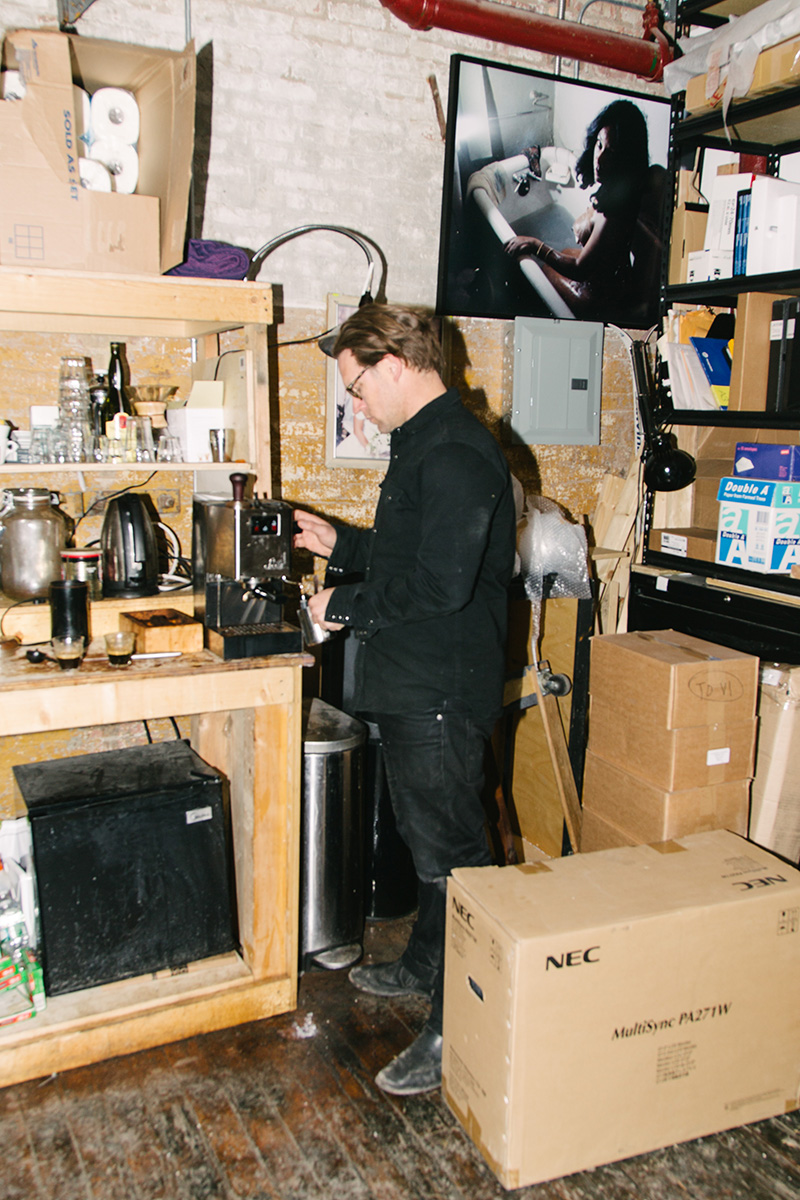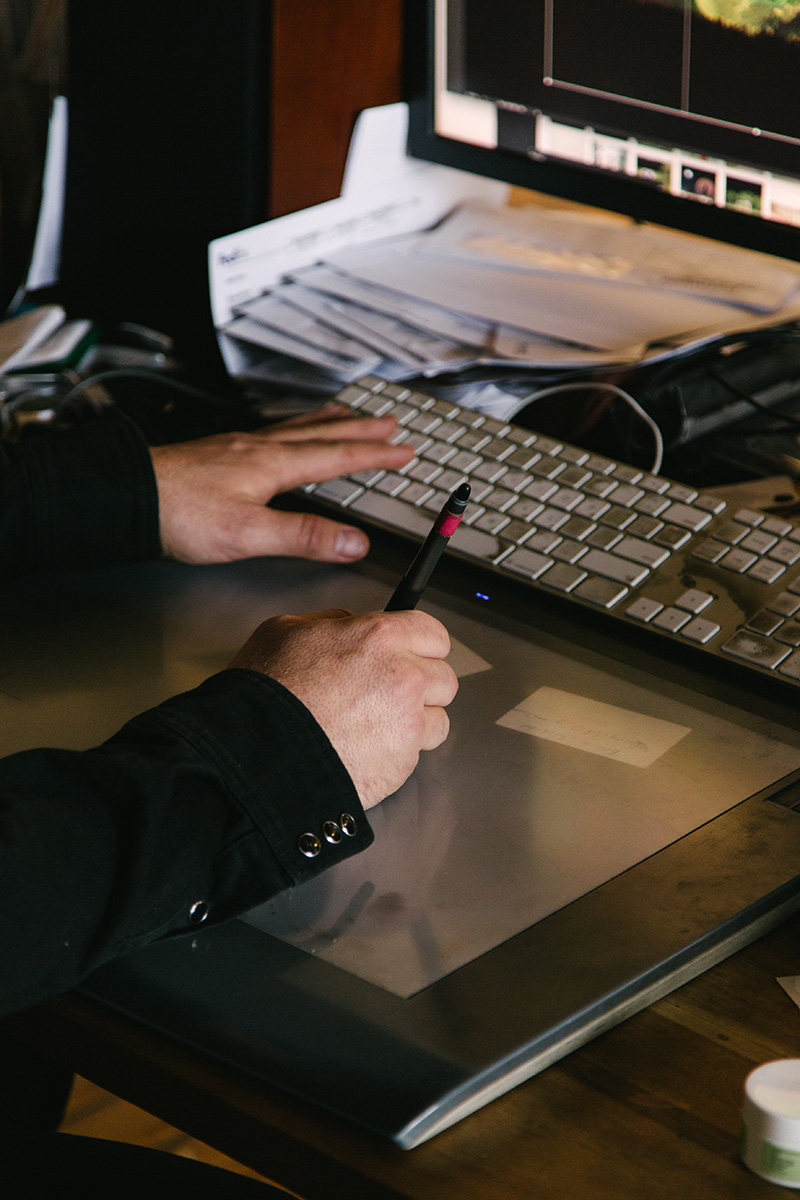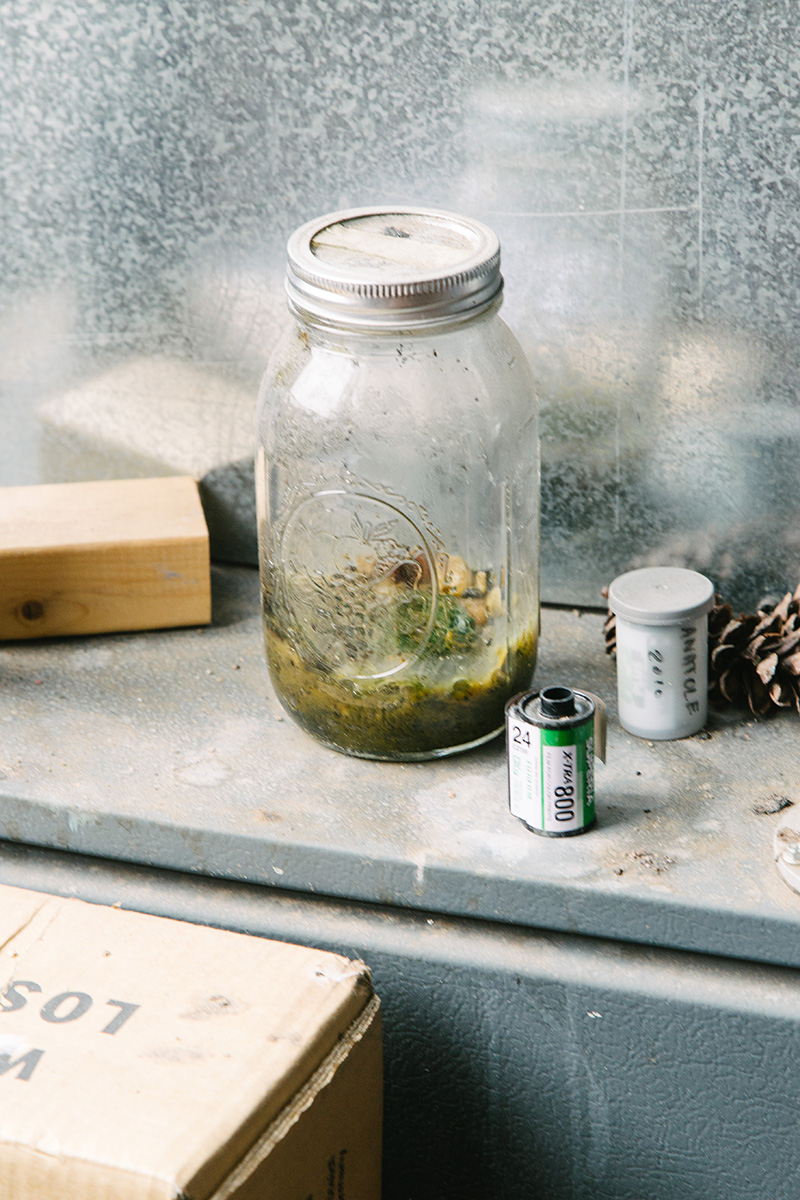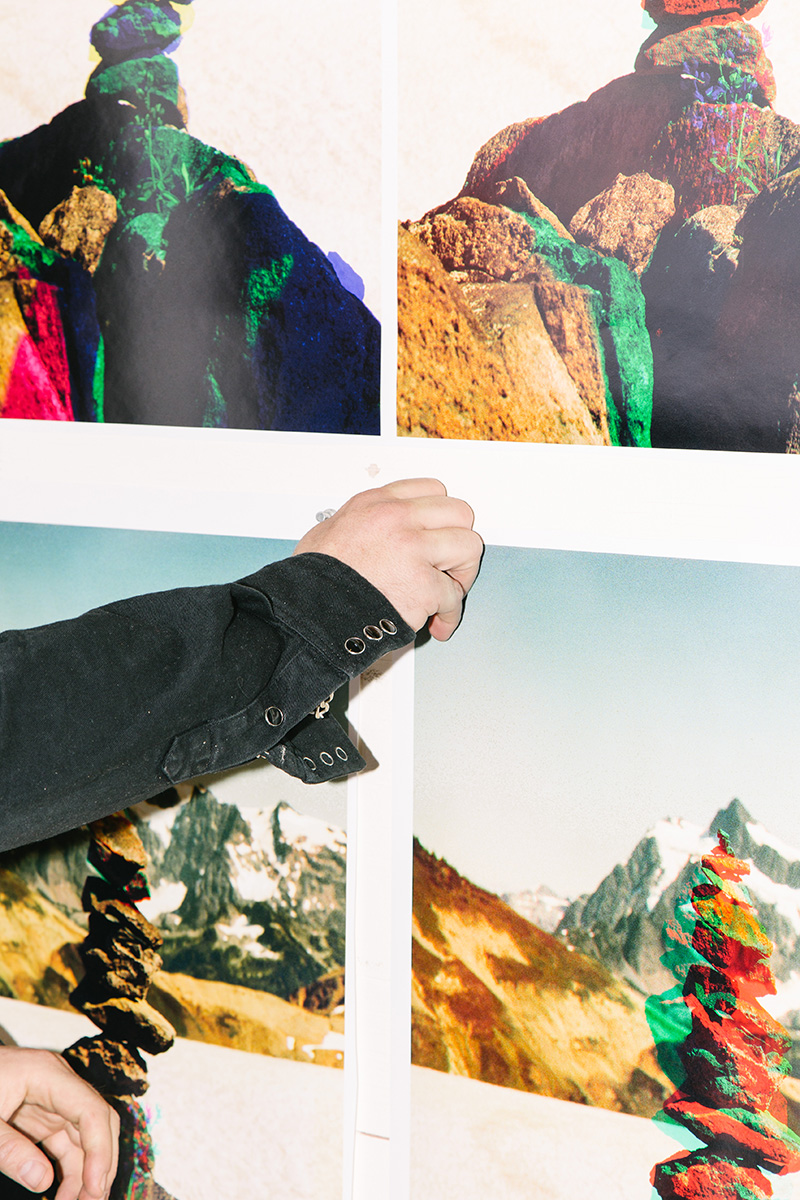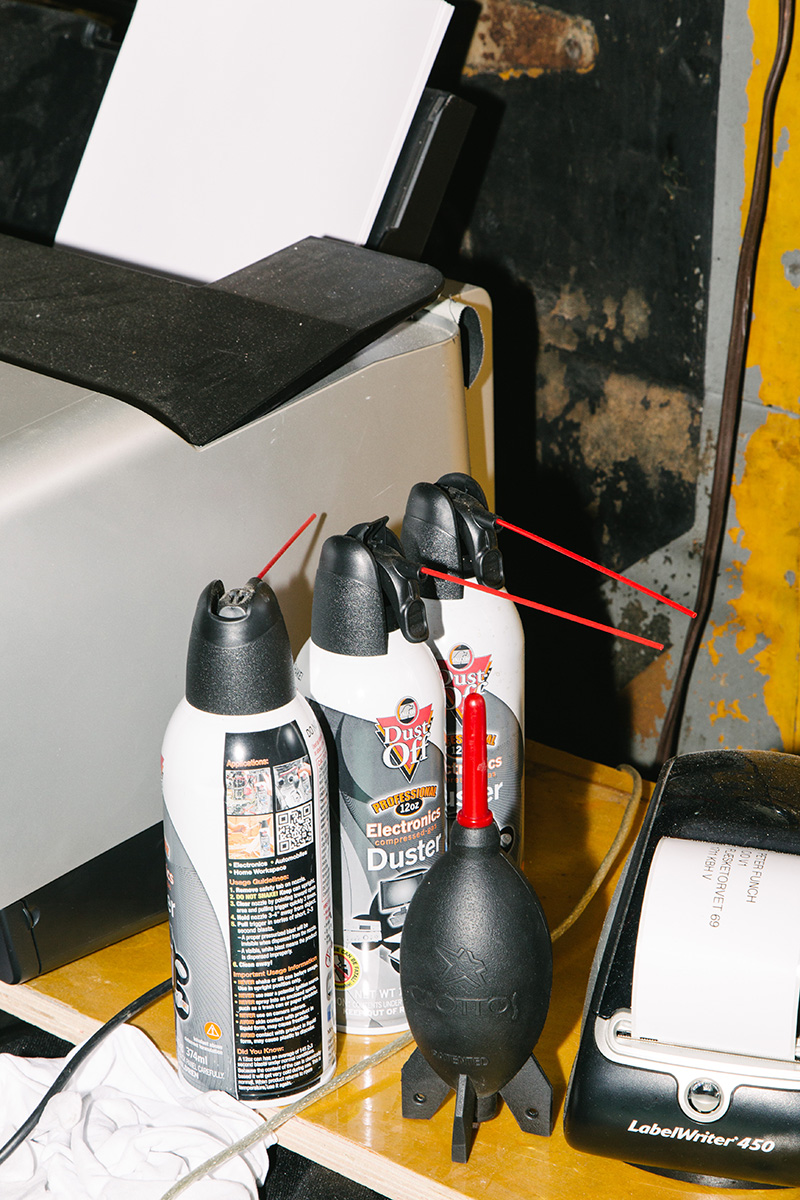Studio Visit: Peter Funch
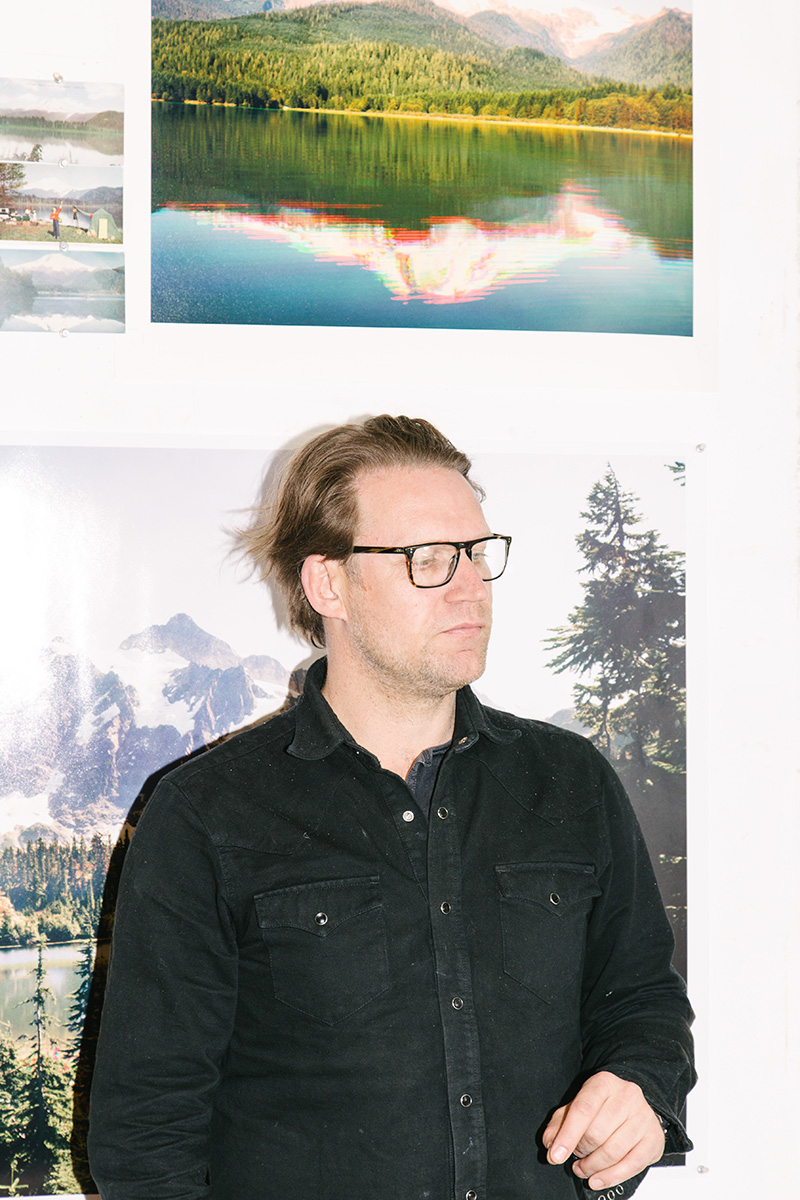
Romke Hoogwaerts (RH): This is a wonderful space. How long did you say you’ve been here?
Peter Funch (PF): I’ve been here three years now. I had my previous studio [in the Lower East Side] for four years.
RH: Does that make it seven years in New York?
PF: Eleven years. Time goes by very quickly.
RH: You’re Danish, right? When did you leave Denmark?
PF: I first moved to London in 2003, maybe. I was there for a little more than a year and then I moved over here.
(Peter hands me a cappuccino he’s just prepared)
RH: Wonderful, thank you. How much has New York changed since you’ve been here?
PF: A lot! Especially when you’re not like an old New York romantic. I mean it’s that development, you can’t avoid it. It’s pretty wild to see how much is changing, how much it’s becoming a new development. Especially when I moved to Greenpoint; it was a place that just three years ago was quiet. Now it’s just fucking business. Internet companies, people that want to make money… you see the change in the way people dress…
RH: I’m sure you pick up on that a lot especially given your kind of photography. The Babel Tales series, it’s a study of people and the city and how they act.
PF: Yeah. It’s funny because now that I’ve moved to Brooklyn, for me it’s a period of being the outsider in New York, observing like a flaneur, fascinated with the myth and the randomness.
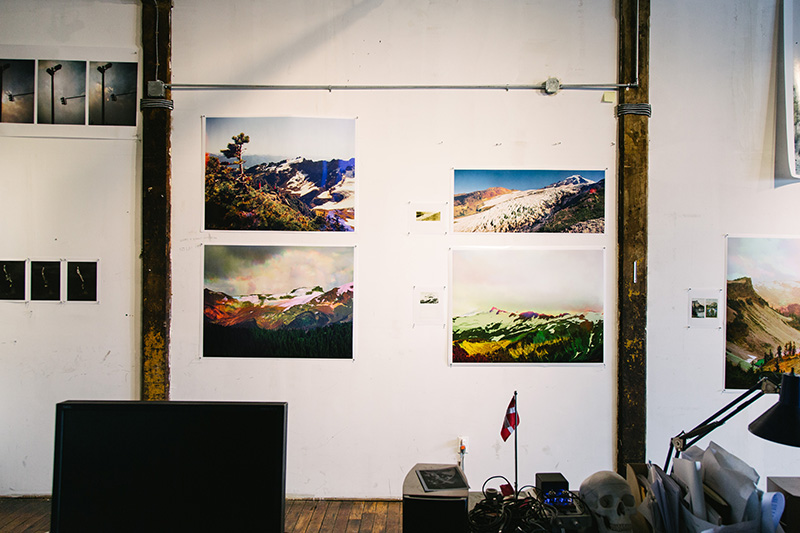
RH: In Denmark, did you grow up in a city?
PF: No, I grew up in a rural area outside the second biggest city, Aarhus, north of Germany. Boring as you can imagine. Then I studied, I moved away as soon as possible when I finished high school and tried to move to London, then came back and studied journalism and photojournalism [and graduated in 1999]. And that kind of brought me to Copenhagen and I continued my life there…
RH: How long were you a photojournalist?
PF: It’s hard to define. I went to Masterclass workshop at World Press Photo [in 2003] which was amazing but I think that was kind of my goodbye to it; I mean, fantastic workshop, amazing people, amazing way of meeting people and talking about photography, but I was like, OK. This is not what I’m doing. I know I’m not doing this anymore. I’m not denying it, I really appreciate the way of making stories… I think I just [wanted to] expand it.
We walk around the studio for a minute.
RH: [pointing to photograph on the wall] So, this is your newest project…
PF: That’s the last project I did, called Expedition Mount Baker. It’s done together in collaboration with Project Pressure, which is this kind of archive of retreat of glaciers.
RH: It’s a different style than your other photos, it’s a different camera…
PF: In Babel Tales I used the technique of going back again and again in the same point of view. I love that idea of having time being put into photography, almost like a little short film. I don’t know if it’s because of the trend of process based photography but I’ve always been looking back at older techniques and been fascinated with this separation. Like how we started doing colour photography, a process where you shoot a red green and blue, a beginning, a middle and an end, which means there’s narrative in it. It also gives a sense of time, that it’s something that is in transition.
RH: So you shoot the colours separately.
PF: Yes, the technique also reminds me of painting.
RH: I noticed that it seems you have a strong influence from painting, like in Danish Diaries, those landscapes feel very painterly. Cinema is definitely a stronger element, especially in Babel, even the dimensions of it but also the scale, it makes you feel like you’re in the movies.
PF: Yeah. In one part sure, it’s documentary, but I fictionalise it with the way I composite it. I’m cheating or playing with the idea of fiction.
RH: I’ve seen in other interviews that people are quick to ask what you like about the fiction of it, but in a way it’s not quite fiction, is it? It all happened, this is just amalgamating it into one shot.
PF: Yeah, it’s just that [those particular subjects in Babel Stories] haven’t been there all at the same time. It’s still a document of what people have in common.
RH: It’s so expertly well done. You know, I can never really find the edges [between subjects in Babel Stories photographs].
PF: [laughs] We spend so much time on printing now looking at the real-size prints, wondering if they look real…
RH: Who do you work with?
PF: It’s a guy from Denmark, I call him Red Bear. He’s become a good friend. We met and got absolutely drunk the first time and it was like, okay we can work together. [laughs]
RH: That’s how you know you’ve got a good relationship!
PF: We got good food and got absolutely drunk… [Peter’s phone rings]

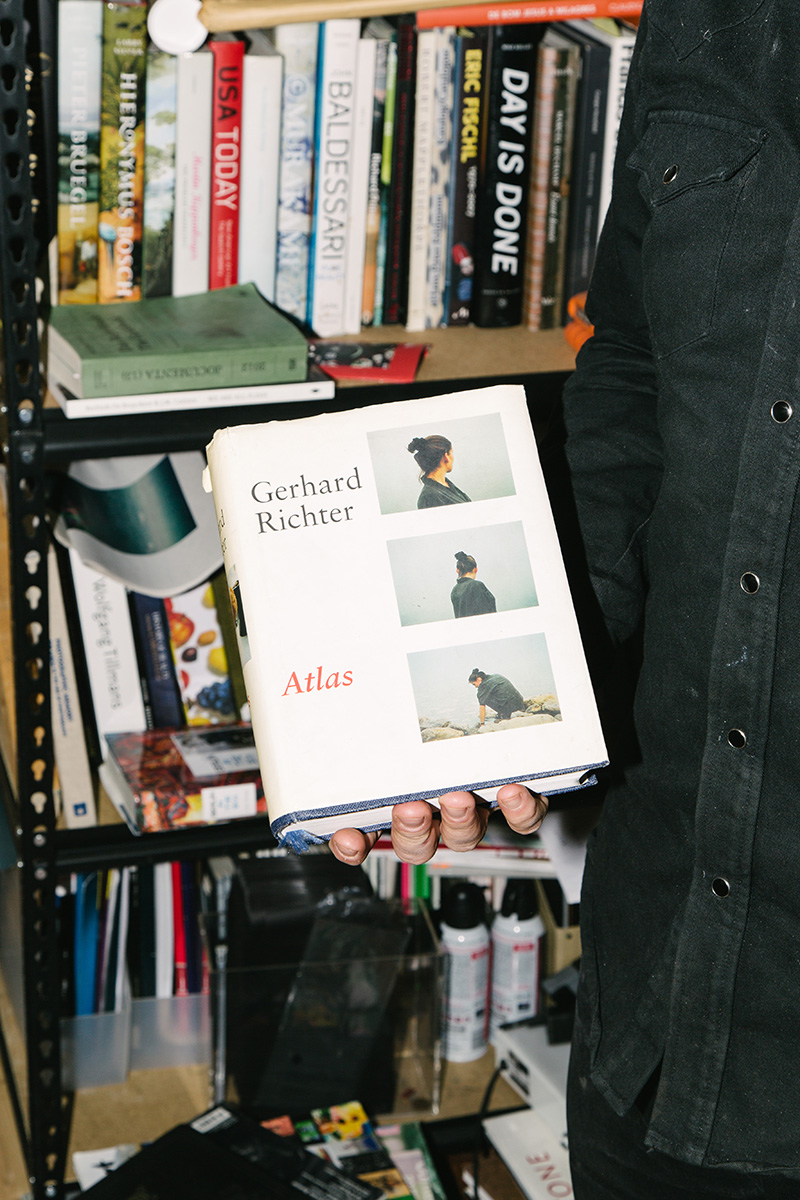
RH: I know that [in Babel Tales] your photographs are manipulated to have these moments come together, but have you ever seen a moment like this unfold in front of your eyes? Where everything seems to come together in this perfect way? But maybe you didn’t have a camera?
PF: Yeah but in a little more contrived way, where it’s not funny, it doesn’t have that kind of musical humanistic element.
RH: Which one gets the strongest responses?
PF: There was a blog a few years ago…
RH: You mean it has circled around the internet?
PF: Yeah… [he flips through his prints] Which was it? There was the one of yawning.
RH: Ah yeah, that’s one I loved as well.
PF: [Flips through more prints] These are some of the first one from down at Chambers and Church [Street] where I lived. I started going back to the same area every day, photographing the same place, over and over again.
RH: Did you have the exact same spot?
PF: You can cheat a little bit, but I had a tripod and three spots on the ground.
RH: [We find the yawning print] There! And all the cabs in the background, that’s a nice detail. Is that part of it as well?
PF: These closer ones are much more composed. The background was moving, there’s not really any static elements here so I composed the background and then I composed the foreground. Compared to these [wider shots] where I was dependent on the pavement, the buildings, it’s shot as-is. I’m really fond of these where it’s not so obvious what they have in common. You play with the title of Two to Tango, indicating what it’s about.
RH: Seeing them as prints give them a different feel because they’re so much larger and there’s so many details. I remember when I saw it for the first time in Amsterdam, actually.
PF: Ron Mandos [Gallery]?
RH: A couple years ago [in 2009] there was one print that really stuck with me — the Headroom photo. I thought that one was really beautiful, but it’s one you have to see in person. The details are finer, it speaks volume about the culture [of Islam in New York City] and how the city sort of pushes it away. It’s very interesting. Do you still return to Babel Stories? It’s a long time ago now, relatively. Do you think about shooting more of it?
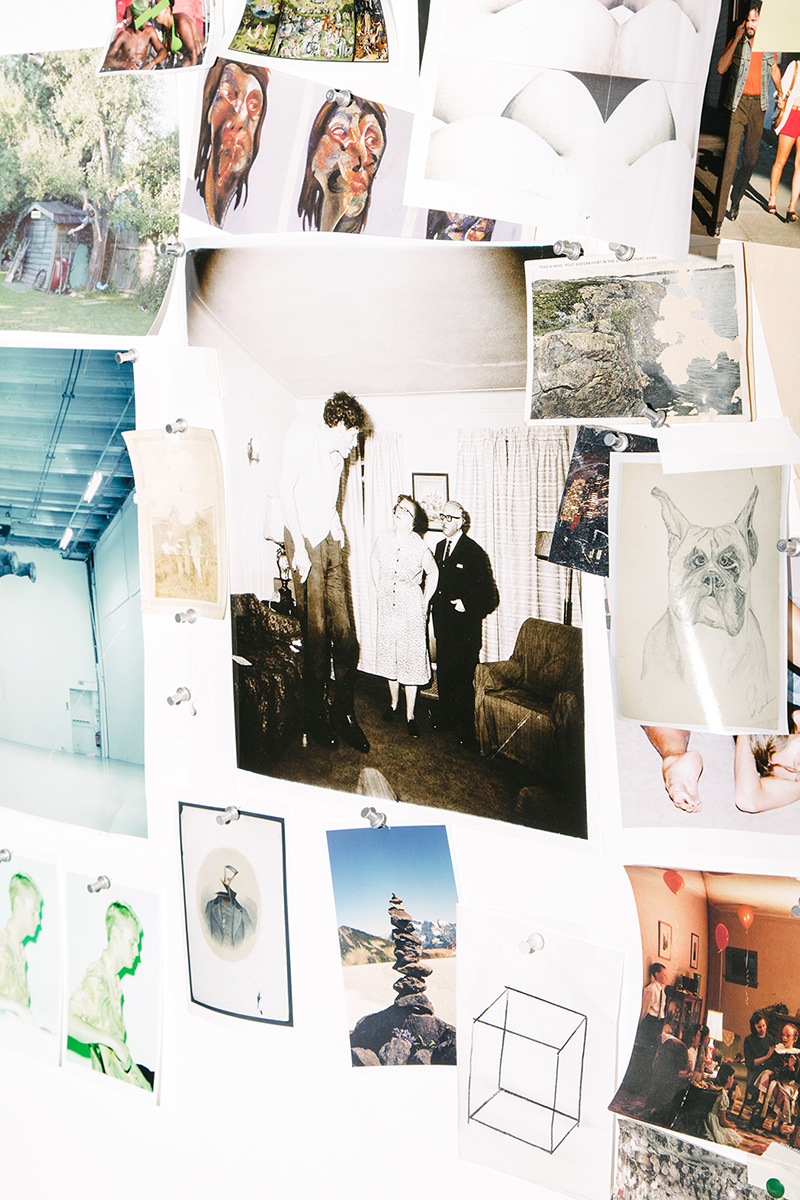
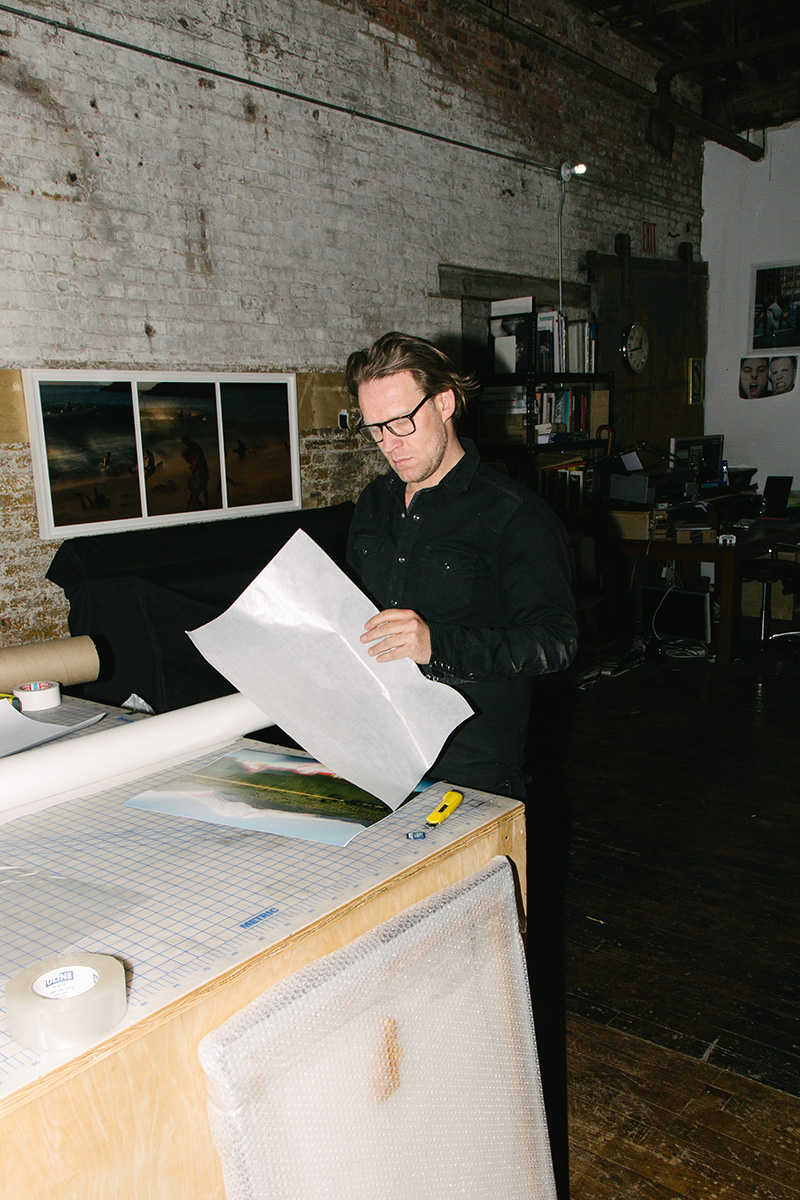
PF: No, I started a project which was a continuation of it, outside Grand Central Station. I was shooting the people coming out, and the people I recognise I keep on shooting. At some point I make contact with them.
RH: Commuters?
PF: Yeah, but the element of [them being a] stranger or not a stranger. Once I get their name, I start Googling them, getting all sorts of information about them so I continued it, but added another element. It’s not about the manipulation of it and what we have in common, it’s about the person [within a] society. But I’m still working on it [laughs].
RH: That’s interesting. I’m sure the series attracted a lot of commercial work for you.
PF: Yeah for sure, that whole natural documentary style, manipulated, was five years ago; they just wanted to buy into it, into the idea… they almost just want to put their logo straight onto it. It’s sort of like come on guys, get your own ideas! [laughs]
RH: It’s interesting how work like this which has a strong fine art purpose, lends itself really well commercial work. How much commercial work do you do?
PF: Very little now. I’m very happy and proud to… well it’s coming out now, I did the campaign for the new Whitney Museum.
RH: Oh cool! I didn’t realise that was you.
PF: That was such an amazing project to work on. It was this idea of taking pieces of the collection at the Whitney and placing them in the Meatpacking area.
RH: Oh that’s so cool. You didn’t actually get to put the painting on the street, did you?
PF: No we did a reproduction, a proper reproduction photo of the piece so we could match it.
RH: So that’s actually a print [in the photo]. How many did you make?
PF: We did seven. First, it’s amazing to work for the Whitney, and it’s also a really good idea.
RH: It’s a great new building.
PF: Yeah! Well, I haven’t been.
RH: I love that they built this room which is in the plans, they have a library, but they also have a zine library. Which is really cool, I’ve never seen a museum do that and it’s a cool new step.
PF: With my commercial work, photography has changed so much in the last five years. I spend my energy just diving into my own projects. I like to do dig production projects and I try to focus on that. Of course I need some money and I try to finance that if not by selling prints. It’s fun to do commercial work but sometimes it takes away from doing these [personal] projects.
RH: Yeah, it’s a necessary evil sometimes. Can I ask something about this series… [I walk over to a wall of prints] The Amelia Earhart Bridge. I wanted to ask something specific. It seems that you photographed the implosion from many different angles. How did you achieve that?
PF: With help from a lot of people. [laughs] It’s a continuation of Babel Tales about this moment that you share. I wanted to expand on that, thinking what if you share a moment of something in transition. From being a bridge to being a ruin, people are observing something that’s not quite defined. So I found this bridge in the middle of America named the Amelia Earhart bridge, which also has this amazing story about her and then I found a really great producer, Doug Emery…
RH: Why do I know that name?
PF: He used to work with Taryn Simon. He’s an amazing researcher and producer to work with. We found a school that had photography [facilities] and they helped us once it was happening. I put up all the cameras, framed it, then once it happened, I pulled the trigger.
RH: That’s really cool.
PF: We had like 13 cameras and 2 drones, all covering the whole scenario.
RH: And the studies [from the series] are all close-ups from those photographs.
PF: So the whole project is about the transition of one place changing into something else. I brought back pieces of the bridge and photographed them through water. I recently found the people who have the remains of the plane that she went down in in Western Australia.
RH: Oh really?
PF: So we’re gonna photograph that in the same way, the pieces of the plane through water.
RH: What do you think is the true story of Amelia Earhart’s end?
PF: It has been proven now that she went down in water. The pieces they found, they now have the photo of the plane where they can see that specific piece that they found was a repair of the plane. But the story about her continues…
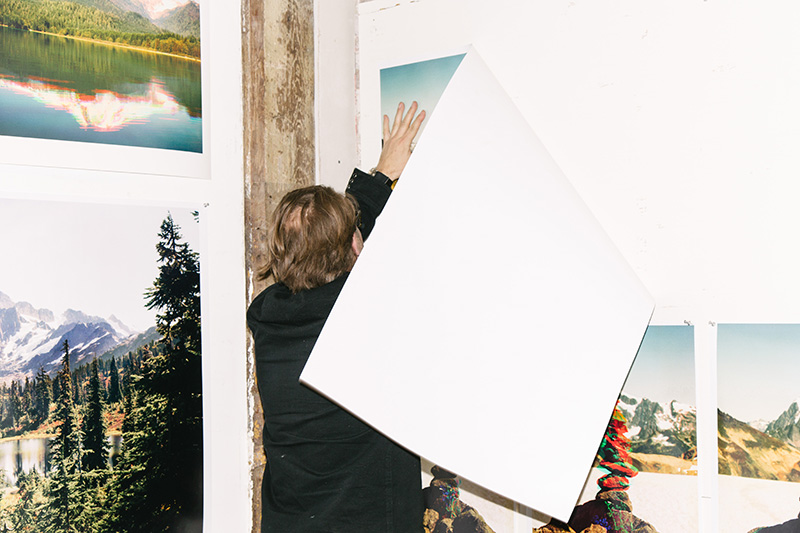
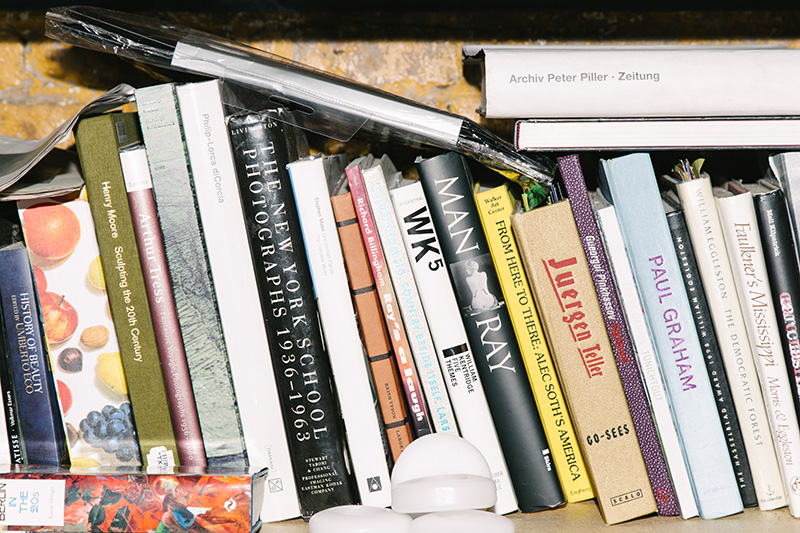
RH: What was it like working with Études for this book?
PF: Good! Super nice, it was a very fast turnaround.
RH: And they sold very quickly, I believe.
PF: I would say, of course you could ask what is such a high-end fashion brand doing with photo books? But they’re just so dedicated and they make it such a delicate part of their image that it’s pretty nice to be a part of.
RH: I believe it’s how they started? I thought that Je Suis un Bande De Jeunes was what they used to be and then they morphed into Études, then Études became a fashion brand as well; I think they’re fascinating, I’ve always loved their books. Have you exhibited a lot in the US?
PF: Not a lot. Here in New York I’ve exhibited at Volta [show art fair in 2008], I did a show in Chelsea [at a satellite of Copenhagen-based V1 Gallery in 2011].
RH: I’ve seen that you’ve had a lot of shows in Europe, in your experience is there a difference between exhibiting in the US and in Europe?
PF: Babel Tales was very approachable for Europeans; they have a very romantic idea of New York. They are going to have a little part of New York on their walls… I don’t know. I’ve been very focused on America while I’ve been over here, maybe I’m too focused on it.
RH: What is the name of your upcoming work?
PF: I’m working on a continuation on glaciers [for Expedition Mount Baker], more mountains, not only glaciers, expanding the area. It’s not only… [Peter shows me a previous version] like a postcard, now it’ll be more scientific, with elements where you can make comparisons. But now I’ve started including puzzles…
RH: Oh, that’s so cool. Did you make this?
PF: Well, I put together the puzzle, I just bought it on eBay.
RH: Oh, I see! Are you going to rephotograph it?
PF: Yeah, just as an object.
RH: That’s so cool. I see what you mean.
PF: I’m trying to include many more things, more stories from the area, so it’s not only about the glaciers but also the nature which is changing our behaviour.
RH: You know, it reminds me of Babel Tales, with that title. Babylon doesn’t exist anymore.
[At this point I bring up Faust and wonder if there’s an element of human power and destruction at play in his work].
PF: My dad and I used to talk about this a lot but it’s not only about that. Also with the glaciers, it’s a man-made surface destruction of earth, but it’s not only about that!
RH: What else do you think about when you think about Babel, the name, in relation to your work?
PF: I used the reference only because of the idea of people having something in common. That moment of having something in common and then the moment after you do not. The relationship between other people that you don’t really acknowledge or you don’t see on the street; the coincidence, the randomness of that but also the small poetic moment that you share with another. I used the film Smoke as a reference, when he’s sitting in the back showing all of his pictures he’s been taking out of a tobacco shop at 11, and his friend coming over and he’s peering through the photos and he says, oh, that’s my ex-wife here! Then after a few more pages, oh, it’s my ex-wife again!
RH: What do I see here? Oh, this is a maquette for an exhibition…
PF: This is for Kunsthalle in Denmark, a group show. I always do the 3d models because I want to break the idea of how you see the show, that images are on temporary walls standing in a line in the middle of a room; you have to make your own story out of it.
RH: And playing with that tangible space is something that cinema will never be able to do.
PF: Yeah! [laughs] That’s why I start doing this, it’s a very nice help for me to understand what a place is going to look like.
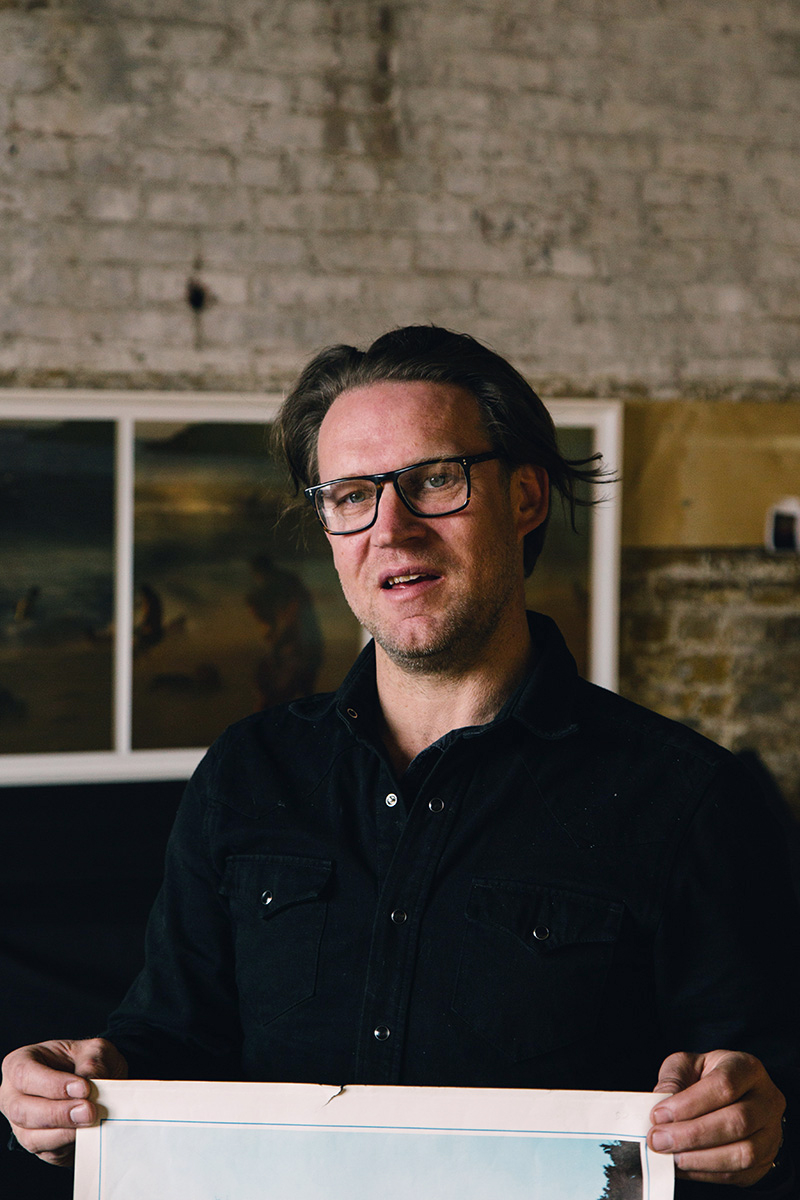
We move to the shelves of photo books.
RH: Do you have any favourite photobooks here that you might want to point out?
Peter snaps his fingers as he looks around.
PF: Hmm, you know I love this Tillmans’ Manual, where is it…
[Peter shows me a bunch more books and dummies from previous projects. We talk a little about the people making his books].
PF: I’ve been looking a lot at Pierre Huyghe, a French artist. I’ve been looking a lot at Olafur Eliasson, cause I’m Danish. I’ve been reading a lot of conversations with Hans Ulrich Obrist.
RH: I’ve recently been reading more about Olafur Eliasson through this philosopher Jenny McMahon who is from Adelaide, she wrote a really interesting treatise on the function of art and contemporary art, it’s really interesting stuff. [Eliasson] invites the most interesting people to his studio…
[We then looked at a few other books and noticed that spine and cover of a book had Wolfgang Tillmans printed on it but its contents were about someone else].
PF: Maybe they were a little bit drunk. [laughs]
RH: Do you have any close peers in the industry?
PF: Asger Carlsen and I moved over here together.
RH: Oh cool! I didn’t realise.
PF: Well, I was here a little bit before with some Danish friends…
RH: That’s so interesting though, you guys have a very different style but also work with manipulation.
PF: Jesper Joost, who does video…
RH: Ah, I love the work that he did in Detroit. Adam Kremer! I see his name there.
PF: Yeah, he worked with me for a long time.
[I see a postcard of a mountain].
RH: What is this, Mount Rainier?
PF: Yeah. I’ve been buying postcards of Mount Rainier and Mount Saint Helens for the last year. I’ve just been taking it down because I’m putting a window over here. [Peter points to a wall within his studio, behind is a small room]
RH: What’s next door?
PF: It used to be my storage, I’m going to rent it out now for a studio. So if you know anyone… it’s a nice little space.
RH: Good to know. I’ll plug that. [laughs]
PF: So [continuing his explanation of his project] we’ll get the map, hike like maniacs I think here [he points to a spot on his map] in September, finding all the locations for the postcards, all the ones I’ve been buying, finding stories about this woman who lost a husband in the mountain in the fourties.
RH: [I pick up an old portrait] Her?
PF: Yeah, an old press photo from the Seattle Times, with the whole story on the back. I’ve tried to find other stories about it.
RH: Where did you get this photo?
PF: Ebay and libraries over there.
RH: Where do you see yourself for the next five years? Anything you’re working on?
PF: Yeah! Finishing this with the glaciers, I see this kind of connected as a bigger project, American Anthology I call it. Last Flight, the glaciers and a third project about NASA. Well, not about NASA but related to it. I’m trying to look further out in a kind of humane, narcissistic way, like the Kepler mission, looking for other planets; not a lot of photography but there’s a lot of calculations about it, a lot of thoughts about it.
RH: Do you have family here?
PF: Yeah, I have a girlfriend and a son. He’s 5 now.
RH: Do you live near your studio?
PF: Yeah I live about five blocks from here. It’s so nice, his school is also here in Greenpoint, I never really leave the area.
RH: Do you bike around everywhere?
PF: Pretty much! Like the Dutch, Danish… everywhere, all year round. That’s it!
